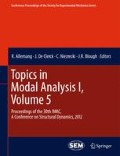Abstract
An effective identification method is developed for the determination of modal parameters of a structure from its measured ambient nonstationary vibration data. It has been shown in a previous paper of the authors that by assuming the ambient excitation to be nonstationary white noise in the form of a product model, the nonstationary response signals can be converted into free-vibration data via the correlation technique. In the present paper, if the ambient excitation can be modeled as a nonstationary white noise in the form of a product model, then the nonstationary cross random decrement signatures of structural response evaluated at any fixed time instant are shown theoretically to be proportional to the nonstationary cross-correlation functions. The practical problem of insufficient data samples available for evaluating nonstationary random decrement signatures can be approximately resolved by first extracting the amplitude-modulating function from the response and then transforming the nonstationary responses into stationary ones. Modal-parameter identification can then be performed using the Ibrahim time-domain technique, which is effective at identifying closely spaced modes. Numerical simulations confirm the validity of the proposed method for identification of modal parameters from nonstationary ambient response data.
Access this chapter
Tax calculation will be finalised at checkout
Purchases are for personal use only
References
Siringoringo DM, Fujino Y (2008) System identification of suspension bridge from ambient vibration response. Eng Struct 30:462–477
Gentile C, Saisi A (2011) Ambient vibration testing and condition assessment of the Paderno iron arch bridge (1889). Construct Build Mater 25:3709–3720
Cole HA Jr (1971) Methods and apparatus for measuring the damping characteristics of a structure, United States Patent No. 3, 620, 069
Vandiver JK, Dunwoody AB, Campbell RB, Cook MF (1982) A mathematical basis for the random decrement vibration signature analysis technique. ASME J Mech Des 104:307–313
Bedewi NE (1986) The mathematical foundation of the auto and cross-random decrement techniques and the development of a system identification technique for the detection of structural deterioration. Ph.D. Thesis, University of Maryland, College Park
Ibrahim SR (1977) Random decrement technique for modal identification of structures. J Spacecr Rockets 140(11):696–700
Ibrahim SR, Mikulcik EC (1977) A method for the direct identification of vibration parameters from free response. Shock Vib Bull 47(4):183–198
Chiang DY, Lin CS (2008) Identification of modal parameters from nonstationary ambient vibration data using correlation technique. AIAA J 46(11):2752–2759
Shinozuka M, Jan C-M (1972) Digital simulation of random processes and its applications. J Sound Vib 25(1):111–128
Allemang RL, Brown DL (1983) A correlation coefficient for modal vector analysis. In: Proceedings of the 1st international modal analysis conference. Society for Experiment Mechanics, Bethel, pp 110–116
De Angelis M, Lus H, Betti R, Longman RW (2002) Extracting physical parameters of mechanical models from identified state space representations. ASME J Appl Mech 69(5):617–625
Acknowledgements
This research was supported in part by National Science Council of the Republic of China under the grant NSC-96-2221-E-006-188.
Author information
Authors and Affiliations
Corresponding author
Editor information
Editors and Affiliations
Rights and permissions
Copyright information
© 2012 The Society for Experimental Mechanics, Inc. 2012
About this paper
Cite this paper
Lin, CS., Chiang, DY. (2012). Modal Identification from Nonstationary Ambient Vibration Data Using Random Decrement Algorithm. In: Allemang, R., De Clerck, J., Niezrecki, C., Blough, J. (eds) Topics in Modal Analysis I, Volume 5. Conference Proceedings of the Society for Experimental Mechanics Series. Springer, New York, NY. https://doi.org/10.1007/978-1-4614-2425-3_20
Download citation
DOI: https://doi.org/10.1007/978-1-4614-2425-3_20
Published:
Publisher Name: Springer, New York, NY
Print ISBN: 978-1-4614-2424-6
Online ISBN: 978-1-4614-2425-3
eBook Packages: EngineeringEngineering (R0)

